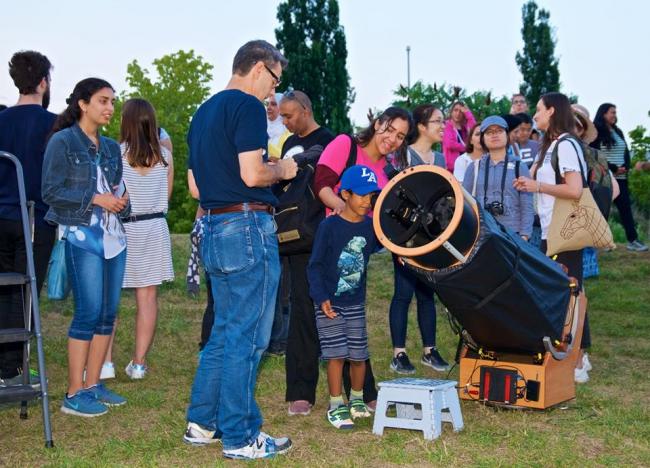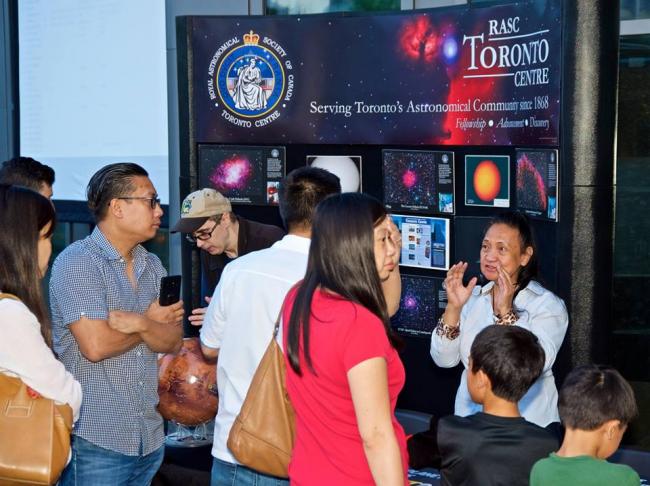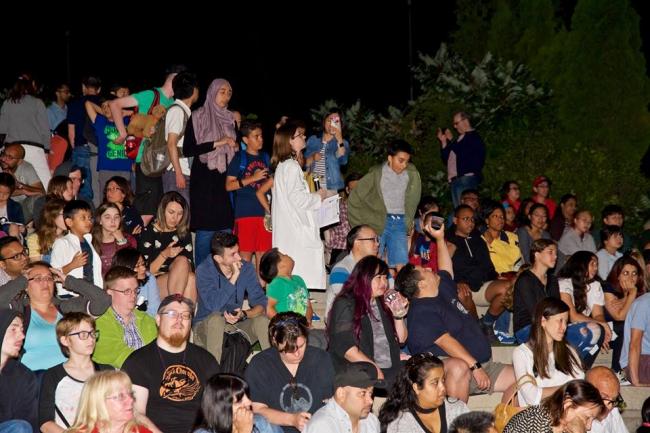
Canada: Ontario Science Centre celebrates Mars Festival
Toronto, Aug 2 (IBNS): Mars Festival, organized by Royal Astronomical Society of Canada (RASC), was observed in Ontario Science Centre from July 27-28.
The festival was hosted from 8 pm to 1 am.
This event was observed because Mars was closest to the earth on that day since 2013.

July’s night skies feature Mars opposition on the 27th, when Mars, Earth, and the Sun all line up with Earth directly in the middle.
For any planet, a year is the time it takes to make one orbit around the sun.
Because Mars is farther away from the sun, it has to travel a greater distance than Earth. It takes Mars about twice as long as it does for Earth to make one circle around the sun.
The interesting feature about this event was that apart from the Planet Mars, RASC had organized several resources for the children as well as adults to have access to the knowledge about other planets as well
The event started at 8 pm on 27th July with large crowds of young and old gathered to observe through telescopes mounted on different spots outside the Ontario Science Centre main reception area to enable viewing different planets by children and adults.

A few volunteers from RASC had also gathered in front of a big table which displayed quizzes and questions about all each of the 9 planets. Children as well as the adults were fully occupied in this and the volunteers answered about any questions they had.
Other volunteers were stationed at different spots to facilitate the eager viewer to view the planets through the telescope and answer any question they had.
In other places children were busy with drawing and colouring and in still other places volunteers were helping children to perform some science experiments based on launching a rocket in space.
A talk by Dr Tanya Harrison had been organized as well.
Tanya Harrison holds a PhD in geology with specialization in Planetary Science and exploration from Western Ontario University and is from Arizona State University's Space Technology and Science Initiative and is on the science team of the Mars Opportunity rover.
In the meantime Dr. Rachel Ward-Maxwell, Researcher-Programmer in Astronomy and Space Sciences at the Ontario Science Centre was busy collecting questions from the audience for Harrison.
After being introduced to the audience by Rachel, Harrison welcomed the audience and said that Mars is the fourth planet from the Sun and the second-smallest planet in the Solar System after Mercury.
It was very dark at that time but the audience were very curious to learn about this spectacular phenomenon and remained seated on the steps in front of the stage where Harrison began to speak.

She added that Mars is a terrestrial planet with a thin atmosphere and has surface features resembling the impact craters of the Moon and the valleys, deserts, and polar ice caps of Earth.
She also said due to the difference in temperature between Mars and Earth these polar ice form clouds which evaporate near the equator where the temperature is much higher and form water pellets which causes a lot of problem for the robot in their functions.
There is also a lot of fog in Mars, continued Harrison which is visible during the early hours of the morning and as the temperature increases on earth the fog disappears.
Dust storms, said Harrison, are very common in Mars and added that heat is the driving force behind dust storms on Mars same as on earth.
On Mars, large amount of loose dust lying on the surface are carried by upward winds. Dust particles in Mars are very fine and small, smaller than sand on Earth, and it hangs in the air, and takes a really long time to settle.
Global dust storms are being experience by Mars at present and the scientific term for these global dust storms in Mars is epic dust storms of Mars.
Some times these Global dust storms change to regional storms taking up the size of whole of Ontario, to the size of North America, to the size of South America and also to the size of North America and South America, sometimes as big as third of planet and at other times covering entire planet.
Scientists usually have robots set up to take pictures.
These robots need to be kept warm. But during dust storms nothing is visible to the robot.
NASA’s Curiosity Rover, continued Harrison, is nuclear powered and not affected by the dust.
RASC has downloaded many pictures of Mars from Curiosity Rover.
Curiosity Rover, continued Harrison, can also take very good selfies.
Different types of clouds are also present on Mars
This speech was followed by the question and answer session between Harrison and audience.
Due to the cloudy weather that day the moon and Mars were clearly visible only around midnight.
(Reporting by Asha Bajaj)
Support Our Journalism
We cannot do without you.. your contribution supports unbiased journalism
IBNS is not driven by any ism- not wokeism, not racism, not skewed secularism, not hyper right-wing or left liberal ideals, nor by any hardline religious beliefs or hyper nationalism. We want to serve you good old objective news, as they are. We do not judge or preach. We let people decide for themselves. We only try to present factual and well-sourced news.







